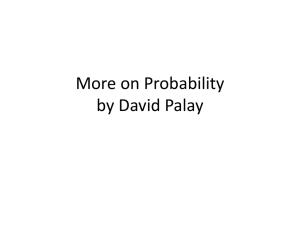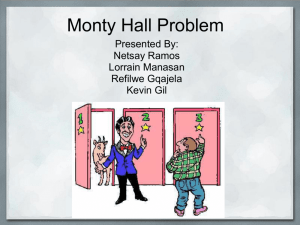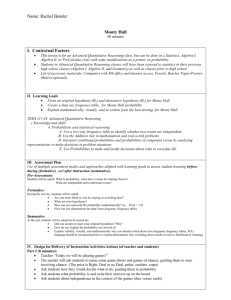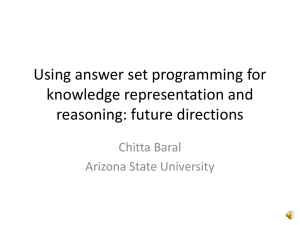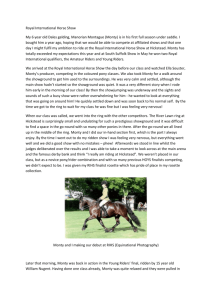GAME SHOW SHENANIGANS: MONTY HALL MEETS MATHEMATICAL LOGIC
advertisement
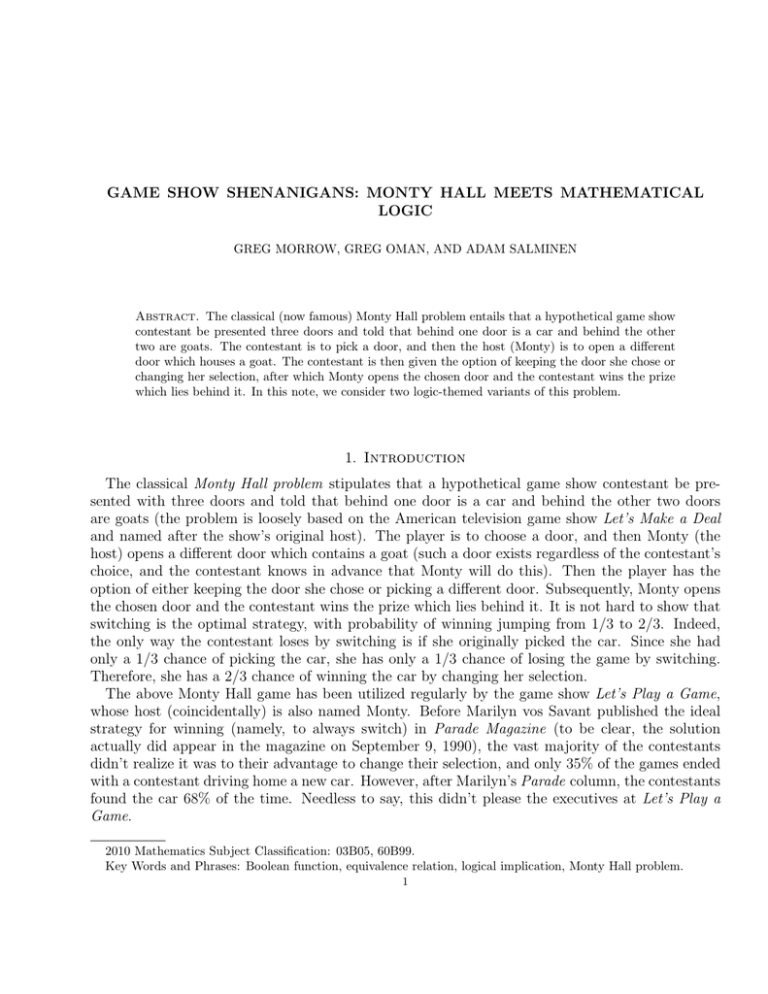
GAME SHOW SHENANIGANS: MONTY HALL MEETS MATHEMATICAL
LOGIC
GREG MORROW, GREG OMAN, AND ADAM SALMINEN
Abstract. The classical (now famous) Monty Hall problem entails that a hypothetical game show
contestant be presented three doors and told that behind one door is a car and behind the other
two are goats. The contestant is to pick a door, and then the host (Monty) is to open a different
door which houses a goat. The contestant is then given the option of keeping the door she chose or
changing her selection, after which Monty opens the chosen door and the contestant wins the prize
which lies behind it. In this note, we consider two logic-themed variants of this problem.
1. Introduction
The classical Monty Hall problem stipulates that a hypothetical game show contestant be presented with three doors and told that behind one door is a car and behind the other two doors
are goats (the problem is loosely based on the American television game show Let’s Make a Deal
and named after the show’s original host). The player is to choose a door, and then Monty (the
host) opens a different door which contains a goat (such a door exists regardless of the contestant’s
choice, and the contestant knows in advance that Monty will do this). Then the player has the
option of either keeping the door she chose or picking a different door. Subsequently, Monty opens
the chosen door and the contestant wins the prize which lies behind it. It is not hard to show that
switching is the optimal strategy, with probability of winning jumping from 1/3 to 2/3. Indeed,
the only way the contestant loses by switching is if she originally picked the car. Since she had
only a 1/3 chance of picking the car, she has only a 1/3 chance of losing the game by switching.
Therefore, she has a 2/3 chance of winning the car by changing her selection.
The above Monty Hall game has been utilized regularly by the game show Let’s Play a Game,
whose host (coincidentally) is also named Monty. Before Marilyn vos Savant published the ideal
strategy for winning (namely, to always switch) in Parade Magazine (to be clear, the solution
actually did appear in the magazine on September 9, 1990), the vast majority of the contestants
didn’t realize it was to their advantage to change their selection, and only 35% of the games ended
with a contestant driving home a new car. However, after Marilyn’s Parade column, the contestants
found the car 68% of the time. Needless to say, this didn’t please the executives at Let’s Play a
Game.
2010 Mathematics Subject Classification: 03B05, 60B99.
Key Words and Phrases: Boolean function, equivalence relation, logical implication, Monty Hall problem.
1
Monty Hall Meets Mathematical Logic
Morrow, Oman, & Salminen
The show recently contracted you, a mathematician, to retool the Monty Hall game so that (a)
playing with optimal strategy is more difficult, and (b) the probability of winning with optimal
strategy is greater than 12 (so as not to incur the wrath of the Game Show Contestant Union)
but less than 32 . The show’s budget for research and development is low, and so they want you
to construct a game which, as in the original, requires a contestant to pick among 3 doors with
prizes hidden behind (some subset of) them. After brainstorming for a couple of weeks, you have
managed to come up with the following variants:
Game One: Truth Triad. A contestant is presented three doors labeled 1, 2, and 3. Further,
the contestant is informed that behind one door is $20,000, behind the other two doors is motor
oil, and that all three doors are equally likely to contain the money. A door number is determined
at random (but not told to the contestant) to house the cash. Monty (the host), who knows where
the green is, randomly chooses a proposition ϕ concerning the location of the cash (this will be
made precise shortly). He then presents ϕ to the contestant. The contestant, after a reasonable
period of time to analyze ϕ, is presented with the truth value of ϕ (true or false, relative to the
randomly chosen door). She then chooses a door, after which Monty opens the chosen door and
the contestant wins the prize which lies behind it.
Game Two: Full Monty. A contestant is presented three doors labeled 1, 2, and 3 as before.
But now, there are no restrictions placed on how many doors have $20,000 behind them, and all
possibilities are equally likely (so, for example, it is possible that all doors house motor oil, and at
the other extreme, that $20,000 is behind every door). This gives 8 equally likely outcomes, and
the contestant is made aware of this fact in advance. One of the 8 prize configurations is chosen at
random, but not revealed to the player. Then Monty randomly chooses a proposition ϕ concerning
the location of the money along with its truth value (again, relative to the prize configuration).
After being given a period of time to ponder the proposition and its truth value, she chooses a
door. As before, Monty opens the chosen door and the contestant wins the prize which lies behind
it.
Excited about your new ideas, you get to work solving the following problems: determine the
optimal strategy for winning the games (i.e. finding money) and, using said strategy, determine
the probability that the contestant will win.
2. Propositional Preliminaries
Now that you have come up with the general idea for two games, it is time to make their
descriptions more precise. What is meant by “a proposition concerning the location of the money?”
You quickly realize that there is a setting which is perfectly suited to give a formal answer to this
question, namely, propositional logic.
The particular language L you have in mind contains three sentence symbols A1 , A2 , and A3 .
The symbol A1 models the assertion, “Money is behind door 1.” Analogous interpretations are
given to A2 and A3 . Further, L contains the usual logical connectives ¬ (not), ∨ (or ), ∧ (and ),
→ (implies), and ↔ (if and only if ) as well as punctuation (, ) for unique readability. The set
2
Monty Hall Meets Mathematical Logic
Morrow, Oman, & Salminen
F of formulas is generated from the sentence symbols using the propositional connectives in the
familiar way. We pause to give a few simple examples of formulas along with their intended English
language translations.
Example 1. We have the following:
(1) formula: A2 ; translation: “ Money is behind door 2.”
(2) formula: A2 ∨ A3 ; translation: “ Money is behind door 2 or door 3.”
(3) formula: (A1 ∨ A3 ) ∧ ¬A2 ; translation: “ Money is behind door 1 or door 3 but not behind
door 2.”
(4) formula: A2 → ¬(A1 ∨ A3 ); translation: “ If money is behind door 2, then money is not
behind door 1 nor behind door 3.”
(5) formula: A1 ↔ ¬(A2 ∨ A3 ); translation: “ Money is behind door 1 if and only if money is
not behind door 2 nor behind door 3.”
Next, fix a set {T, F } consisting of two distinct elements T , called truth, and F , called falsity.
Any function v : {A1 , A2 , A3 } → {T, F } (henceforth called a truth assignment) can be uniquely
extended to a function v : F → {T, F } (cf. [5], Theorem 13A). Again, we pause to present an
example.
Example 2. Suppose that v(A1 ) = T and v(A2 ) = v(A3 ) = F . Then v(A1 ) = v(¬A2 ) =
v(A1 ∨ A2 ) = T , whereas v(A2 ∧ A3 ) = v(A1 → A2 ) = v(A1 ↔ A2 ) = F .
A simple yet important fact is that given any truth assignment v and any formula ϕ, a truth table
enables one to effectively determine whether v(ϕ) = T or v(ϕ) = F .
Finally, you have the tools needed to formalize “a proposition ϕ concerning the location of the
money”: ϕ is simply a formula in the language L defined above. You want Monty to choose ϕ at
random (i.e. you want all propositions to be equally likely to be picked by Monty). This poses a
problem for multiple reasons, but the one with which you are most concerned is the practical one:
Problem 1. There are an infinite number of formulas, so in practice, Monty simply cannot pick
one at random!
So now you’re stuck... but is there a way out? You notice that although there are indeed infinitely
many formulas, there are large groups of them which make the same assertions. For example, the
formulas in S := {A1 , A1 ∨ A1 , (A1 ∨ A1 ) ∨ A1 , . . .} are, in a certain way, all equivalent. But how
does one make this precise? They are equivalent in the following sense: if v is any truth assignment
such that v(α) = T for some α ∈ S, then v(β) = T for all β ∈ S. From this observation, you
are lead naturally to the relation ∼ defined on the set F of all formulas by α ∼ β if and only if
v(α) = v(β) for every truth assignment v. It is a simple matter to verify that ∼ is an equivalence
relation on F (the reader may notice that for any formulas α and β, α ∼ β if and only if α ↔ β is
a tautology; using logical nomenclature, α ∼ β if and only if α β).
Now, if the set of equivalence classes happens to be finite, then you can simply give a complete
set of representatives of F (modulo ∼) to Monty and he can randomly choose one without any loss
of expressiveness. Problem solved! It remains to determine if, in fact, there are but finitely many
equivalence classes. Toward this end, you introduce the following definition.
3
Monty Hall Meets Mathematical Logic
Morrow, Oman, & Salminen
Definition 1. Let {T, F }3 := {T, F }×{T, F }×{T, F }. A (tertiary) Boolean function is a function
B : {T, F }3 → {T, F }.
Let B denote the collection of Boolean functions. It follows from basic combinatorics that
(2.1)
3
|B| = 2(2 ) = 256.
Moreover, every formula ϕ determines a Boolean function Bϕ as follows: let (x1 , x2 , x3 ) ∈ {T, F }3 .
Then Bϕ ((x1 , x2 , x3 )) = the truth value of ϕ when A1 is assigned x1 , A2 is assigned x2 , and A3 is
assigned x3 . More formally, let T denote the collection of all truth assignments v : {A1 , A2 , A3 } →
{T, F }. Then Bϕ ((v(A1 ), v(A2 ), v(A3 )) := v(ϕ), where v varies over T . We pause to present a
concrete example.
Example 3. Let ϕ := (A1 ∨ A2 ) ∧ A3 . Then
(1) Bϕ ((T, T, T )) = Bϕ ((F, T, T )) = Bϕ ((T, F, T )) = T , and
(2) Bϕ ((T, T, F )) = Bϕ ((F, F, F )) = Bϕ ((F, F, T )) = Bϕ ((T, F, F )) = Bϕ ((F, T, F )) = F .
Now, it follows immediately from the definition of ∼ and Bϕ that for any formulas α, β ∈ F,
(2.2)
([5], Theorem 15A, part (b)) α ∼ β if and only if Bα = Bβ .
For ϕ ∈ F, let [ϕ] := {β ∈ F : ϕ ∼ β} be the equivalence class of ϕ modulo ∼. Then (2.2) implies
that the function f : F/∼→ B defined by
(2.3)
f ([ϕ]) := Bϕ
is well-defined and one-to-one. Our first proposition is perhaps less obvious:
Proposition 1 ([5], Theorem 15B). Every Boolean function is of the form Bγ for some formula γ.
Sketch of Proof. Let B be an arbitrary Boolean function, and let k := |B −1 (T )|. We consider
several cases.
Case 1: k = 8. Then B(~x) = T for all ~x ∈ {T, F }3 . In this case, take γ := A1 ∨ ¬A1 .
Case 2: k = 0. Then B(~x) = F for all ~x ∈ {T, F }3 . Now choose γ := A1 ∧ ¬A1 .
Case 3: 1 ≤ k ≤ 7. List all vectors ~x for which B(~x) = T as follows:
~x1 := (x11 , x12 , x13 )
~x2 := (x21 , x22 , x23 )
..
.
~xk := (xk1 , xk2 , xk3 )
Now, for 1 ≤ i ≤ k and 1 ≤ j ≤ 3, define the formula αij by
4
Monty Hall Meets Mathematical Logic
Morrow, Oman, & Salminen
(
Aj
αij =
¬Aj
if xij = T,
if xij = F.
Finally, set βi := αi1 ∧ αi2 ∧ αi3 , and let γ := β1 ∨ · · · ∨ βk . It is not hard to check that B = Bγ ,
completing the proof.
Proposition 1 allows us to conclude that the function f defined in (2.3) is onto. Therefore, there
are exactly 256 equivalence classes of formulas modulo ∼. Not only this, but the previous proof
yields a nice algorithm for choosing a representative from each class. As an added bonus, the proof
shows how to do this in such a way that each chosen formula has a relatively simple form. To
be fair to the contestant and since the show has a limited amount of time to allow the contestant
to deliberate, you are quite happy with your findings. In particular, you have managed to resolve
Problem 1. Having laid the ground work, you are excited to move on and calculate the probability
of winning the new games you created (and since it would be nice to get paid, you cross your fingers
and hope that the probability of winning is between 12 and 32 ).
3. Truth Triad
We begin by reminding the reader of the description of Truth Triad: Mary Contestant is presented
three doors labeled 1, 2, and 3. Further, Mary is informed that behind one door is $20,000 and
behind the other two doors is motor oil, and that the money is equally likely to be behind each of
the three doors. A door number is determined at random (but not told to Mary) and the $20,000
is placed behind the chosen door. Monty, who knows the location of the money, randomly chooses
a proposition ϕ (in the language L introduced in the previous section). He then presents ϕ to
Mary. Mary, after a reasonable period of time to analyze ϕ, is given the truth value of ϕ (relative
to the door chosen to house the money). She then must choose a door, after which Monty opens
the chosen door and the Mary wins the prize which lies behind it.
After setting up the logical machinery in Section 2, you are now able to devise an optimal strategy
for Mary and determine the probability that she wins the money using this strategy. Note first
that the rules of the game allow exactly 3 possible truth assignments (hence the game’s moniker)
v1 , v2 , and v3 defined as follows:
(3.1)
v1 (A1 ) = T, v1 (A2 ) = v1 (A3 ) = F,
(3.2)
v2 (A2 ) = T, v2 (A1 ) = v2 (A3 ) = F,
(3.3)
v3 (A3 ) = T, v3 (A1 ) = v3 (A2 ) = F.
Recall, moreover, that Mary is told in advance that exactly one door is to contain the money, so
she knows that the above truth assignments are the only ones possible. Further, if Mary is given
5
Monty Hall Meets Mathematical Logic
Morrow, Oman, & Salminen
any proposition ϕ (from the set of 256 propositions you’ve given to Monty), she can effectively
determine via a truth table which of the above three truth assignments make ϕ true, if any.
Finally, you are equipped to analyze the game. First, since truth assignments (3.1) - (3.3) are
equally likely, it is easy to see that for any proposition ϕ, the probability PT (ϕ) that ϕ is true
(relative to a randomly chosen assignment from (3.1) - (3.3) above) is
the number of truth assignments in (3.1) − (3.3) making ϕ true
the number of truth assignments in (3.1) − (3.3)
(3.4)
−1
|Bϕ (T ) ∩ {(T, F, F ), (F, T, F ), (F, F, T )}|
.
=
3
It is clear from (3.4) that
PT (ϕ) =
(3.5)
1 2
for any formula ϕ, PT (ϕ) ∈ 0, , , 1 .
3 3
For a randomly selected formula ϕ and for α ∈ {0, 31 , 23 , 1}, let P r(PT (ϕ) = α) denote the
probability that PT (ϕ) = α. Then
(3.6)
P r(PT (ϕ) = 0) = P r(PT (ϕ) = 1) = 1/8, and
(3.7)
P r(PT (ϕ) = 1/3) = P r(PT (ϕ) = 2/3) = 3/8.
To verify (3.6), you begin by simply counting the number of formulas ϕ (again, from the 256 that you
gave to Monty earlier) for which PT (ϕ) = 0. But this amounts to counting the number of Boolean
functions B for which B(T, F, F ) = B(F, T, F ) = B(F, F, T ) = F . Elementary combinatorics
32
yields 25 = 32 such functions. Thus P r(PT (ϕ) = 0) = 256
= 18 . One shows analogously that
P r(PT (ϕ) = 1) = 18 . A similar argument establishes (3.7). Alternatively, note that if one restricts
the domain of the Boolean functions to {(T, F, F ), (F, T, F ), (F, F, T )}, then one obtains but 8
different functions, and (3.6), (3.7) follow.
It is now an hour before Mary is to appear on Let’s Play a Game. One of the doors is randomly
picked, and the show’s staff puts $20,000 behind the chosen door and motor oil behind the other
two. Monty randomly chooses a proposition ϕ to present to Mary, and then Mary is brought on
stage and given ϕ. She is allotted several minutes to analyze ϕ, after which time Monty reveals ϕ’s
truth value (relative to the randomly selected prize configuration) and then asks Mary to choose a
door. Again, we remind the reader that Mary knows that the money is behind exactly one of the
doors. You now consider the possible cases systematically.
Case 1: PT (ϕ) = 0. This is somewhat unfortunate for Mary in that even after Monty reveals
the truth value of ϕ, Mary gains nothing. She can compute (via a truth table, if she is fast enough)
that v i (ϕ) = F for all i ∈ {1, 2, 3} (recall that vi is defined in (3.1) - (3.3)). Since she knows that
exactly one of the three truth assignments (1) - (3) is to be realized, she doesn’t need Monty to tell
6
Monty Hall Meets Mathematical Logic
Morrow, Oman, & Salminen
her that ϕ is false (even though he will); she already figured this out from the truth table. Said
another way, the assumption that the money is behind exactly one of the three doors implies ¬ϕ,
so she has gained no new information. Thus all Mary can do is pick her favorite integer between 1
and 3, and the probability of winning is 1/3.
Case 2: PT (ϕ) = 1. The analysis proceeds exactly as in Case 1, and again, the probability of
winning is 13 .
Case 3: PT (ϕ) = 13 . Then there is a unique i ∈ {1, 2, 3} such that v i (ϕ) = T . Moreover, by a
truth table, Mary can find i. Now, if Monty tells her that ϕ is true, then Mary wins: the money is
behind door i. If Monty tells her that ϕ is false, then Mary knows the money is not behind door
i, and thus the probability Mary will find the cash is 21 . Therefore, the probability that Mary will
find the $20,000 in this case is 13 · 1 + 23 · 21 = 23 .
Case 4: PT (ϕ) = 23 . The analysis proceeds as in Case 3, and the probability of Mary of winning
is 23 in this case as well.
At long last, you have enough data to compute the probability of Mary finding the money.
Theorem 1. The probability P1 that a contestant playing Truth Triad with optimal strategy will
7
(or 58.3%).
win is 12
Proof. By (3.6), (3.7), and Cases 1 - 4 above, the probability that a contestant playing with optimal
1
7
strategy will win is P1 = 81 · 13 + 18 · 13 + 38 · 32 + 38 · 32 = 12
+ 12 = 12
.
4. Full Monty
As we did with Truth Triad in the previous section, we quickly review Full Monty for the reader.
Mary is presented three doors labeled 1, 2, and 3. But now there are no restrictions placed on how
many doors house the money, and all possibilities are equally likely. This gives 8 equally likely
outcomes, and Mary is made aware of this in advance. One of the 8 configurations is chosen at
random, but not revealed to her. Then Monty randomly chooses a proposition ϕ and presents it
to Mary along with its truth value (relative to the randomly chosen prize configuration). Again,
she is informed in advance that this will be done. After being given a period of time to ponder
the proposition and its truth value, she chooses a door. Then Monty opens the chosen door and
she wins the prize which lies behind it. Note that there is no loss of generality in assuming that
Monty gives Mary a true proposition relative to the randomly chosen prize configuration, since a
false proposition can be negated (by us and by Mary). Henceforth, we shall assume that Mary is
always given a true proposition by Monty and, moreover, that Mary knows in advance that she will
be given a true proposition.
Before beginning our analysis, a few remarks are in order. Recall that in Truth Triad, Mary starts
off (before Monty’s help, that is) with a 33.3% probability of finding the money. With Monty’s
assistance, the probability increases by 25%. In Full Monty, it is easy to see that Mary begins with
a 50% chance of finding money. However, Truth Triad endows Mary with more knowledge than
does Full Monty. Specifically, she knows that money will be behind exactly one door. Playing Full
7
Monty Hall Meets Mathematical Logic
Morrow, Oman, & Salminen
Monty, Mary goes in blind. Therefore, you don’t expect Monty to be as helpful to Mary as he
was in the first game. After the smoke clears, will Mary be better off playing Truth Triad or Full
Monty? Let’s find out.
Your first goal is to determine Mary’s optimal strategy for finding money (note that we omit the
article “the” preceding “money” because money may lie behind multiple doors). Toward this end,
you set up some notation. As before, for a proposition ϕ, let Bϕ denote the corresponding Boolean
function. For 1 ≤ i ≤ 3, let πi : {T, F }3 → {T, F } be projection onto the ith coordinate.
Describing the optimal strategy is fairly straightforward. Suppose that it has been randomly
determined which doors (if any) house money. The formal model is simply that a member of
{T, F }3 is chosen at random, and for 1 ≤ i ≤ 3, there is a T in the ith coordinate if and only if
there is money behind the ith door. Now, Monty picks a formula ϕ that is true relative to the
chosen configuration (formally, if ~x ∈ {T, F }3 is picked at random, then ϕ is also chosen randomly
subject only to Bϕ (~x) = T ). Mary may construct a truth table to find the function Bϕ . For a fixed
formula ϕ and 1 ≤ i ≤ 3, let P rϕ (i) denote the probability that money lies behind door i (given
ϕ). Then it is easy to see that
P rϕ (i) =
(4.1)
=
the number of members of Bϕ−1 (T ) with a T in the ith coordinate
the cardinality of Bϕ−1 (T )
|Bϕ−1 (T ) ∩ πi−1 (T )|
.
|Bϕ−1 (T )|
Thus Mary’s best strategy is to choose i ∈ {1, 2, 3} such that |Bϕ−1 (T ) ∩ πi−1 (T )| is a maximum
(note that there may be multiple such i).
Now that you have determined the optimal strategy for winning the game, you turn your attention
to the global problem of finding the probability that Mary Contestant will win $20,000 using the
strategy just described. You have a nice insight into how to transform this probability problem
into an elementary linear algebra problem. Toward this end, in what follows, we denote F by 0 and
T by 1. This conversion allows you to represent Boolean functions as certain 8 × 4 binary matrices
(that is, as matrices all of whose entries are either 0 or 1). The details follow.
1
1
1
1
1
0
1
0
1
1
0
0
Let x := , y := , and z := . Then notice that for any formula ϕ, the Boolean
0
1
1
0
1
0
0
0
1
0
0
0
function Bϕ can be represented by the 8 × 4 matrix [x y z bϕ ], where for each i, 1 ≤ i ≤ 8,
bϕi := Bϕ (xi , yi , zi ). It should now be clear to the reader how the definitions of x, y, and z came
into being: the set of rows of the matrix [x y z] is precisely the domain of the Boolean function
Bϕ for any formula ϕ. Let us agree to call the matrix Mϕ := [x y z bϕ ] the Boolean matrix of ϕ
8
Monty Hall Meets Mathematical Logic
Morrow, Oman, & Salminen
(matrices whose entries are all either 0 or 1 are often called Boolean matrices, (0, 1) matrices, or
logic matrices). Let FM H denote the collection of the 256 formulas given to Monty earlier. Then
{Mϕ : ϕ ∈ FM H } = {[x y z v] : v ∈ {0, 1}8 }.
(4.2)
Moreover, if α, β ∈ FM H are distinct, then Bα 6= Bβ . Thus
if α, β ∈ FM H are distinct, then Mα 6= Mβ .
(4.3)
You are almost ready to determine the probability of Mary winning Full Monty. The following
lemmas will be required.
Lemma 1. Let ϕ ∈ FM H . The probability that Monty chooses ϕ and presents it to Mary (recall that
we reduced to the case where Monty only presents true formulas to Mary relative to the randomly
ϕ ·bϕ
.
chosen prize configuration) is b1024
Proof. The original probability space for Full Monty consists of all 2048 equally likely points
(x, y, z, ϕ) such that (x, y, z) ∈ {0, 1}3 and ϕ ∈ FM H . Since we reduced to the case where Monty
only presents true formulas to Mary relative to the randomly chosen prize configuration, we fold
the probability space to consist of 1024 equally likely points (x, y, z, ϕ) that satisfy the condition
Bϕ (x, y, z) = 1, with the understanding that (x, y, z) is identified with the Boolean triple determined
by the dictionary F = 0 and T = 1. Indeed, given any fixed prize configuration (x, y, z) ∈ {0, 1}3 , it
is easy to see that there are precisely 27 = 128 many ϕ ∈ FM H such that Bϕ (x, y, z) = 1. Now, for
any ϕ ∈ FM H , we have that ϕ is a true proposition for anywhere from 0 to 8 different prize configurations (x, y, z). The actual number is given as the number of 1s in bϕ , or bϕ · bϕ , since for precisely
bϕ · bϕ many rows of Mϕ we have a prize configuration (x, y, z) such that Bϕ (x, y, z) = 1. We have
established that the folded probability space has 1024 equally likely points and for ϕ ∈ FM H , there
are bϕ · bϕ prize configurations such that Bϕ (x, y, z) = 1. The result now follows.
Lemma 2. Suppose that Monty has given the formula ϕ to Mary. Using optimal strategy, the
ϕ y·bϕ , z·bϕ )
probability of Mary choosing a door which houses money is equal to max(x·bb,ϕ ·b
.
ϕ
Proof. The proof consists, essentially, of “translating” (4.1) to the realm of Boolean matrices. So
assume that Monty has given ϕ to Mary. Recall from (4.1) that the probability that money lies
behind door 1, given ϕ, is given by
the number of members of Bϕ−1 (T ) with a T in the 1st coordinate
the cardinality of Bϕ−1 (T )
the number of rows of Mϕ whose first and last entries are 1
(4.4)
=
the number of 1s in bϕ
ϕ
x·b
= ϕ ϕ.
b ·b
Analogous arguments apply for doors 2 and 3, and the proof is complete.
9
P rϕ (1) =
Monty Hall Meets Mathematical Logic
Morrow, Oman, & Salminen
You are now equipped to prove your second theorem:
Theorem 2. The probability P2 that a contestant playing with optimal strategy will win Full Monty
is 41
(or 64.0625%).
64
Proof. The probability of winning Full Monty with optimal strategy is given by
X
P2 =
(probability ϕ will be chosen)(probability of finding money, given ϕ)
ϕ∈FM H
X bϕ ·bϕ max(x·bϕ , y·bϕ , z·bϕ ) ×
(by Lemmas 1 and 2)
=
1024
bϕ · bϕ
ϕ∈FM H
X
1
max(x·bϕ , y·bϕ , z·bϕ )
=
1024 ϕ∈F
MH
X
1
=
max(x·v, y·v, z·v) (by 4.2)
1024
8
v∈{0,1}
1
× 656 (this follows from a direct computation)
1024
41
= ,
64
concluding the argument.
=
Success! You are quite happy with yourself for a job well-done: both games you invented are
less likely to pay dividends to the contestant than the original game, and the optimal strategies
require much more of the player than simply memorizing “I should always switch.” Your next task:
convince the execs to give you a shot at playing for a car before they usher in your new games (and
your 1995 Ford station wagon gives up the ghost).
Acknowledgment The authors thank Gene Abrams for reading a preliminary draft of this manuscript
and offering several helpful suggestions.
References
[1]
[2]
[3]
[4]
[5]
[6]
[7]
H. Bailey, Monty Hall uses a mixed strategy, Math. Mag. 73 (2000), no. 2, 135–141.
J. Baratgin, Updating our beliefs about inconsistency: the Monty-Hall case, Math. Social Sci. 57 (2009),
no. 1, 67–95.
P. Baumann, Single-case probabilities and the case of Monty Hall: Levy’s view, Synthese 162 (2008), no.
2, 265–273.
G.M. D’Ariano, R.D. Gill, M. Keyl, R.F. Werner, B. Kümmerer, H. Maassen, The quantum
Monty Hall problem, Quantum Inf. Comput. 2 (2002), no. 5, 355–366.
H. Enderton, A mathematical introduction to logic. Academic Press, New York - London, 1972.
L. Fernandez, R. Piron, Should she switch? A game-theoretic analysis of the Monty Hall problem,
Math. Mag. 72 (1999), no. 3, 214–217.
P. Gawron, Noisy quantum Monty Hall game, Fluct. Noise Lett. 9 (2010), no. 1, 9–18.
10
Monty Hall Meets Mathematical Logic
[8]
[9]
[10]
[11]
[12]
[13]
[14]
[15]
Morrow, Oman, & Salminen
R. Gill, The Monty Hall problem is not a probability puzzle, Stat. Neerl. 65 (2011), no. 1, 58–71.
K. Levy, Baumann on the Monty Hall problem and single-case probabilities, Synthese 158 (2007), no. 1,
139–151.
S. Lucas, J. Rosenhouse, A. Schepler, The Monty Hall problem, reconsidered, Math. Mag. 82 (2009),
no. 5, 332–342.
G. Nihous, A generalization of the Monty Hall problem, Math. Sci. 34 (2009), no. 2, 94–98.
J. Rosenhouse, The Monty Hall problem. The remarkable story of math’s most contentious brainteaser.
Oxford University Press, Oxford, 2009.
J. Schuller, The malicious host: a minimax solution of the Monty Hall problem, J. Appl. Stat. 39 (2012),
no. 1, 215–221.
J. Sprenger, Probability, rational single-case decisions and the Monty Hall problem, Synthese 174 (2010),
no. 3, 331–340.
C. Zander, M. Casas, A. Plastino, A.R. Plastino, Positive operator valued measures and the quantum Monty Hall problem, An. Acad. Brasil. Cienc. 78 (2006), no. 3, 417–422.
(Greg Morrow) Department of Mathematics, The University of Colorado, Colorado Springs, CO
80918, USA
E-mail address: gmorrow@uccs.edu
(Greg Oman) Department of Mathematics, The University of Colorado, Colorado Springs, CO
80918, USA
E-mail address: goman@uccs.edu
(Adam Salminen) Department of Mathematics, University of Evansville, Evansville, IN 47722,
USA
E-mail address: as341@evansville.edu
11

